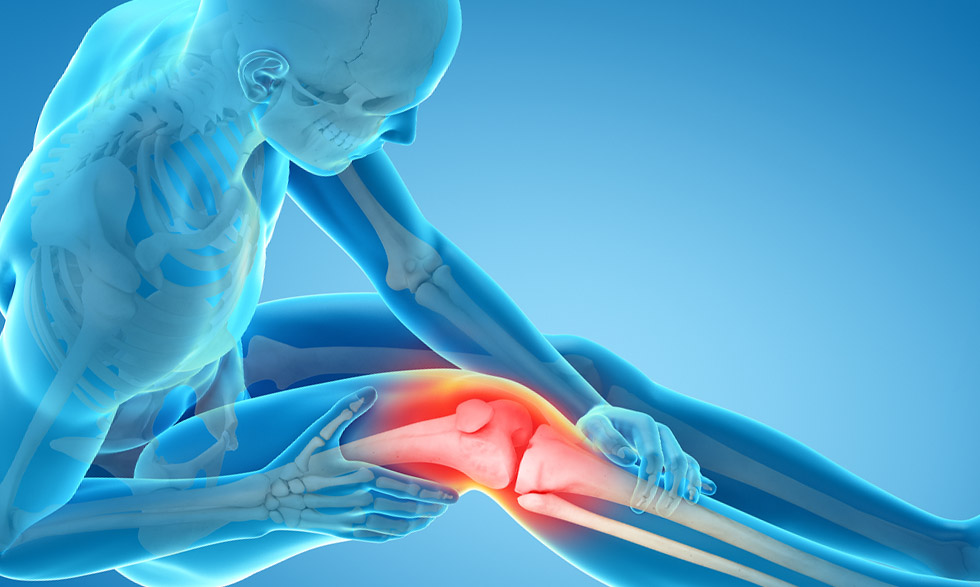With total knee replacement surgery, researchers are looking beyond simply reducing pain. The hope is to return patients to the same high level of activity they had before surgery—like participating in sports or even running marathons.
"People would like to go back and be long distance runners or high performing athletes," said orthopedic surgeon Joshua J. Jacobs, M.D. NIH's National Institute of Arthritis and Musculoskeletal and Skin Diseases (NIAMS) supports Dr. Jacobs' research.
"In the research community we want to figure out a way to make better and better implants."
- Joshua J. Jacobs, M.D.
The surgery involves replacing weight-bearing surfaces of the knee joint. Patients who commonly have this surgery have arthritis in their knees. Arthritis affects an estimated 54.4 million adults in the U.S. It causes joint inflammation, pain, swelling, and stiffness.
"Where the technology is now, the total knee replacement operations are effective for reducing pain and improving function. But we have a ways to go before we can assure our patients that this surgery can allow the extreme levels of activity that one can do on a healthy joint," said Dr. Jacobs, who works at Chicago's Rush University Medical Center.
Improving knee implants
An important step forward would be to make knee implants last longer. Current replacement joint surfaces can wear away after 15 to 20 years. Providers often delay surgery because of an implant's limited lifespan.
Despite the name, total knee replacement doesn't replace all of the knee joint. Doctors put in an artificial joint (implant or prosthesis), composed of different human-made parts.
Replacement joints are made of a mix of metal, ceramic, or plastic. They are designed so that certain materials, like metal, always border with others, like plastic. This creates smoother movement and less implant wear-and-tear.
Even though implant materials have improved since knee replacement surgery first started more than 50 years ago, Dr. Jacobs and his colleagues strive for more improvements.
They are exploring new types of material combinations. Dr. Jacobs is researching how implant surfaces or materials release different kinds of debris from a patient's natural bone or tissue. Materials with less impact on the body could make for better implants.
"That interaction actually is quite important. In many cases, it determines the outcomes of the joint reconstructions and will dictate how long the implant will function well in a particular patient," said Dr. Jacobs.
"In the research community we want to figure out a way to make better and better implants that are both longer lasting and allow the functions that our patients seek," Dr. Jacobs said.
Treatment doesn't end at surgery
Implant success also relies on patient work after surgery. Recovery and continued physical activity are key to lasting knee replacement success.
In a clinical trial, supported by NIAMS, Elena Losina, Ph.D., and her team looked at how physical activity can improve total knee replacement outcomes.
"Many researchers noticed that people who had complained about a lot of pain prior to surgery are very grateful that the pain is gone," Dr. Losina, of Brigham and Women's Hospital in Boston, explained. "But what other researchers noticed was that while the pain is gone, people were not getting more physically active."
Her clinical study used one-on-one coaching and reward money to get 200 patients to become more active after surgery. To measure progress, patients wore activity trackers and reported key information in real time.
The study helped patients understand how physical activity contributes to long-term recovery. The money offered immediate encouragement to get active.
"We found that joint intervention, which includes both coaching using motivational interviewing and financial incentives, substantially improves the number of steps that total knee replacement recipients did daily and the total minutes of physical activity," Dr. Losina said.
For patients who are advised by a physician that they may need total knee replacement surgery, Dr. Jacobs says the first step is talking to an orthopedic surgeon or specialist.
"You need to be evaluated by a health care professional who can zero in on the diagnosis of where you are with your pain," he said.







